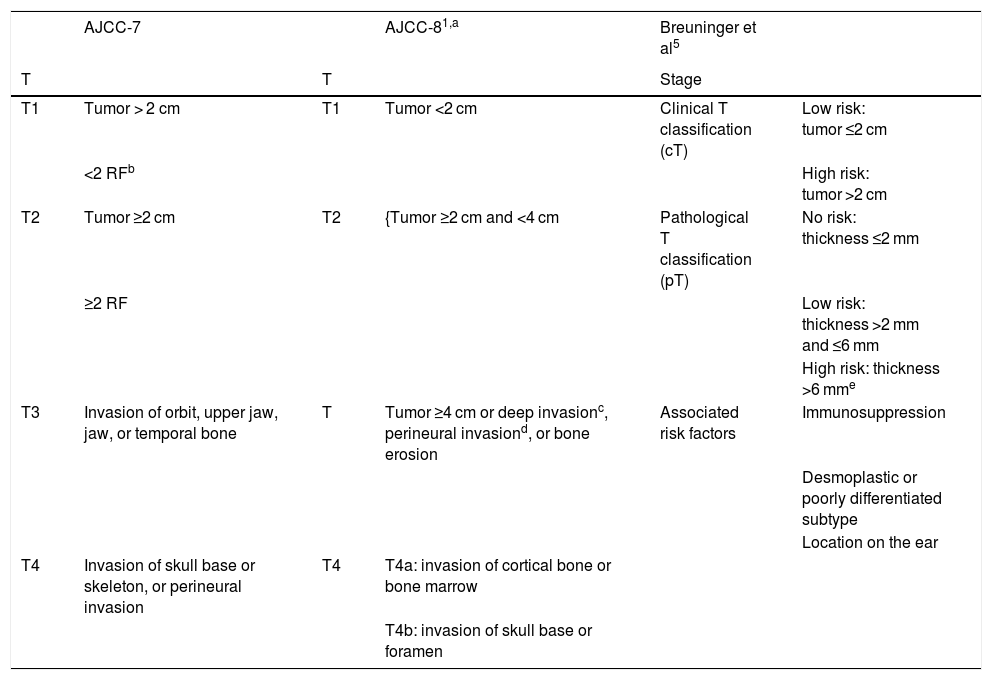Squamous cell carcinoma (SCC) can cause high morbidity and mortality. For this reason, various staging systems have been developed to evaluate the prognosis and guide the treatment of SCC.
The eighth edition of the American Joint Committee on Cancer (AJCC-8) staging system for SCC of the head and neck was implemented in January 2018.1 AJCC-8 introduces significant changes with respect to AJCC-7. Among these changes are the definitions of high-risk factors, which include tumor size ≥4 cm, infiltration >6 mm, invasion beyond subcutaneous cellular tissue, perineural invasion, and bone erosion, and exclude factors such as the degree of histological differentiation (Table 1).2 A recently published study compared AJCC-7 with AJCC-8, assessing the following aspects of each staging system: distinctiveness (differences in outcomes between categories); homogeneity (similarity of outcomes within categories); and monotonicity (worsening of outcomes with increasing categories).3 The classification systems were applied to 680 tumors (459 patients) diagnosed between 2000 and 2009, and poor outcomes (local recurrence, lymph node metastasis, and specific mortality) were recorded. The majority of the tumors were classified as T1 (AJCC-7, 66.2%; AJCC-8, 76.9%), with a mean size of 0.8 cm. Approximately 59% were well differentiated and 7% had perineural invasion. Only 0.3% of tumors were classified as T4 (AJCC-7/AJCC-8). Applying the AJCC-7 staging system, the majority of poor outcomes (83%) were associated with T1–T2 tumors, and only 17% with T3–T4 tumors. By contrast, the majority of poor outcomes (70%) were associated with high AJCC-8 tumor categories (T3–T4b) and only 17% with T1–T2 tumors. The majority of AJCC-8 classification failures involved cases of poorly differentiated tumors. Based on these results, the study concluded that AJCC-8 offers improved homogeneity and monotonicity with respect to AJCC-7 (McNemar P < 0.001).3 Another population-based study conducted by Roscher and coworkers assessed the validity and utility of 4 staging systems (the AJCC-7, AJCC-8, Breuninger et al,5 and Brigham and Women’s Hospital [BWH] staging systems).4 The study analyzed 2 groups of patients: 103 cutaneous SCC (cSCC) patients with metastasis (58% male; mean age, 72.7 years) and 81 cSCC patients without metastasis, selected at random and matched for age and sex at diagnosis. The 4 staging systems showed poor-to-moderate performance in distinguishing patients with metastasis from those without. The AJCC-8 system performed better than that of AJCC-7, but poorer than the Breuninger et al and BWH staging systems. For the Breuninger et al and BWH staging systems, the risk of metastasis increased significantly with increasing tumor stage. External validation revealed the best results for the Breuninger et al system, showing high sensitivity (77.3%) and specificity (75%) and correct classification of 76% of tumors.4 This simple staging system is based on tumor size and thickness, and 3 associated risk factors, which include the desmoplastic subtype and poorly differentiated tumors5 (Table 1).
Comparison of the Different Stages of Cutaneous Squamous Cell Carcinoma
| AJCC-7 | AJCC-81,a | Breuninger et al5 | |||
|---|---|---|---|---|---|
| T | T | Stage | |||
| T1 | Tumor > 2 cm | T1 | Tumor <2 cm | Clinical T classification (cT) | Low risk: tumor ≤2 cm |
| <2 RFb | High risk: tumor >2 cm | ||||
| T2 | Tumor ≥2 cm | T2 | {Tumor ≥2 cm and <4 cm | Pathological T classification (pT) | No risk: thickness ≤2 mm |
| ≥2 RF | Low risk: thickness >2 mm and ≤6 mm | ||||
| High risk: thickness >6 mme | |||||
| T3 | Invasion of orbit, upper jaw, jaw, or temporal bone | T | Tumor ≥4 cm or deep invasionc, perineural invasiond, or bone erosion | Associated risk factors | Immunosuppression |
| Desmoplastic or poorly differentiated subtype | |||||
| Location on the ear | |||||
| T4 | Invasion of skull base or skeleton, or perineural invasion | T4 | T4a: invasion of cortical bone or bone marrow | ||
| T4b: invasion of skull base or foramen |
Source: Breuninger et al.5.
Abbreviations: AJCC, American Joint Committee on Cancer; RF, risk factors.
AJCC-8 only considers cutaneous tumors of the head and neck, excluding those located in the eyelid.
Risk factors according to AJCC-7: thickness >2 mm, poor degree of differentiation, perineural infiltration, involvement of the ear or lower lip, Clark level IV–V of invasion.
Deep invasion: invasion beyond subcutaneous cell tissue, tumor thickness >6 mm (measured from the granular layer of adjacent normal epidermis to the base of the tumor).
Staging systems should be simple and reproducible, and provide relevant information to determine prognosis and guide treatment. While AJCC-8 appears to be superior to AJCC-7, the benefits of excluding certain parameters, such as the degree of histological differentiation, are debatable. The inclusion of the degree of differentiation in other staging systems, such as those of Breuninger et al and the BWH, may explain their superior performance.
Please cite this article as: Morgado-Carrasco D., Bosch-Amate X., Fustà-Novell X., García-Herrera A. FR - Estadificación del carcinoma cutáneo de células escamosas: desafíos e interrogantes. Actas Dermosifiliogr. 2020;111:261–262.




